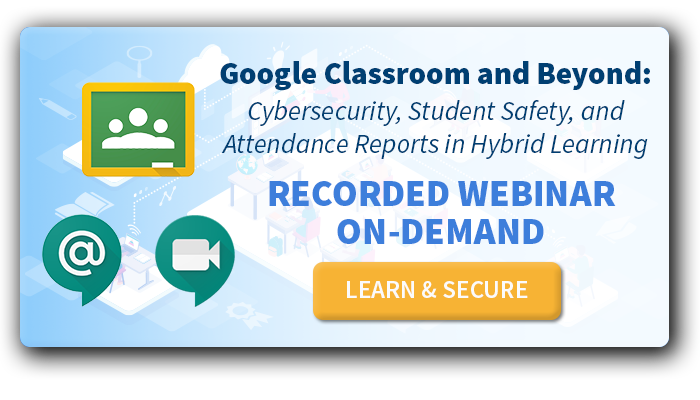The lack of comprehensive admin controls in Google Classroom worries district IT teams and administrators
Many districts have made the move to Google Classroom as their primary Learning Management System (LMS). Google built Classroom with students and teachers in mind, but it lacks many of the administrative tools and controls that IT admins are used to having for other Google Workspace apps. As a result, there are growing concerns about Google Classroom safety for students, as well as securing online classrooms for data privacy and security reasons.
Further, IT admins are becoming increasingly frustrated with the lack of Google Classroom monitoring, reporting, and admin tools that would help them help teachers and students troubleshoot issues, manage “orphaned” Classrooms, re-assign owners, and other common administrative needs that should be easy, but are cumbersome.
Google Classroom safety concerns range from data privacy to student behavior. There were already many reports about students using shared Google Docs as chat rooms to share explicit images, bully each other, and engage in inappropriate behavior before the majority of learning went online. With the increased use of Google Classroom, and the Google Workspace apps that integrate with it, problems like this are expected to increase.
On the other hand, the student data privacy issues that Google’s terms of service and practices bring up caused the New Mexico Attorney General to decide to file a lawsuit against Google. The suit alleges that Google has engaged in deceptive practices in violation of COPPA and the New Mexico Unfair Practices Act.
Districts expect a significant increase in the number of teachers and students using Google Classroom in the coming weeks and months. The increased usage is bringing Google Workspace for Education security and Google Classroom safety to the top of everyone’s mind.
Is Google Classroom Safe?
Like most other school-sanctioned cloud applications your students use, you can manage many Google Classroom safety concerns using the Admin Console. However, student behavior problems such as sharing explicit photos, using inappropriate language, and bullying still take place. It’s a problem because the Google Classroom monitoring capabilities aren’t up to par with other Google Workspace apps. It’s largely the teachers’ burden to manually find and stop such behavior in Classroom.
Many districts have responded to this limitation by locking down the students’ ability to create their own Classrooms and post announcements or comments in Classroom. If your district wants to take this approach, you can prevent students from accessing these features by making adjustments in your domain’s Google Classroom security settings.
But some schools and teachers would prefer to allow students to do these things to help promote collaborative learning. And foster at least some semblance of community that they used to enjoy in physical classrooms. It would be nice if the Classroom product team would provide a better level of visibility and control over the app. Or, at the very least, develop the APIs that will allow Google’s third-party partners to build better Google Classroom admin capabilities.
Another element of Google Classroom safety is that of access. Of course, you will want to restrict who can access your schools’ Classrooms. Access from some outside domains may be warranted for different grade levels, classes, and/or special education needs. You’ll want to restrict outside domain access to your domain’s Classrooms, and then set up an approved list of domains that will be granted access. This access configuration is fairly straightforward to set up in the Admin Console.
How Well does Google Classroom Protect Student Data Privacy?
The New Mexico lawsuit highlights some important concerns about student data privacy in Google Classroom. Parents and privacy advocates are concerned about the collection and use of information about a child’s location, where they engage, and where they browse while online. They’re concerned about Google using this private data for their own commercial purposes, and about third parties gaining access to the data.
This particular issue will continue to play out—likely for many years. Today, the Google Workspace for Education Agreement describes Google Classroom safety, security, and privacy terms.
For the record, the Common Sense Privacy Program gives Google Classroom privacy an 88%, which is a passing grade. Their review of Google Classroom describes why the app received that grade and how it scored in various categories, including data collection, data sharing, data security, and more.
Who Can Monitor Google Classroom Safety & Student Behavior?
Right now, it’s up to the teachers and support staff to monitor student safety and behavior manually in Google Classroom. Admins can control domain and Organizational Unit access to Classrooms, but they don’t have helpful controls over safety and behavior.
For example, admins don’t have visibility over students’ comments in Classrooms. While they can monitor and control other Google Workspace apps like Gmail and Docs and create automated policies based on text or image content, that capability isn’t currently available in Google Classroom.
The Google Classroom safety and student behavior issue has yet to play out in a significant way in our new hybrid learning world. I’m betting that this will evolve much like this spring’s transition to Google Meet and Zoom did. There will be incidents of bad behavior that push the Classroom product team to develop better monitoring and control capabilities at an administrative level.
Safety is just one of the Google Classroom security issues that district IT teams are grappling with right now. There have been some great new updates to Google Classroom from a learning management standpoint, making it a more fantastic tool for teachers and students.
Unfortunately, IT admins and help desk support teams will likely face a lot of Google Classroom admin pain before the product team gets around to beefing up administrative controls and third party API capabilities.

![[WEBINAR ON-DEMAND] Monitoring Google Classroom & Beyond. LEARN & SECURE >>](https://no-cache.hubspot.com/cta/default/6834707/abc8b992-1139-4eef-8046-11b3175e8ccf.png)
